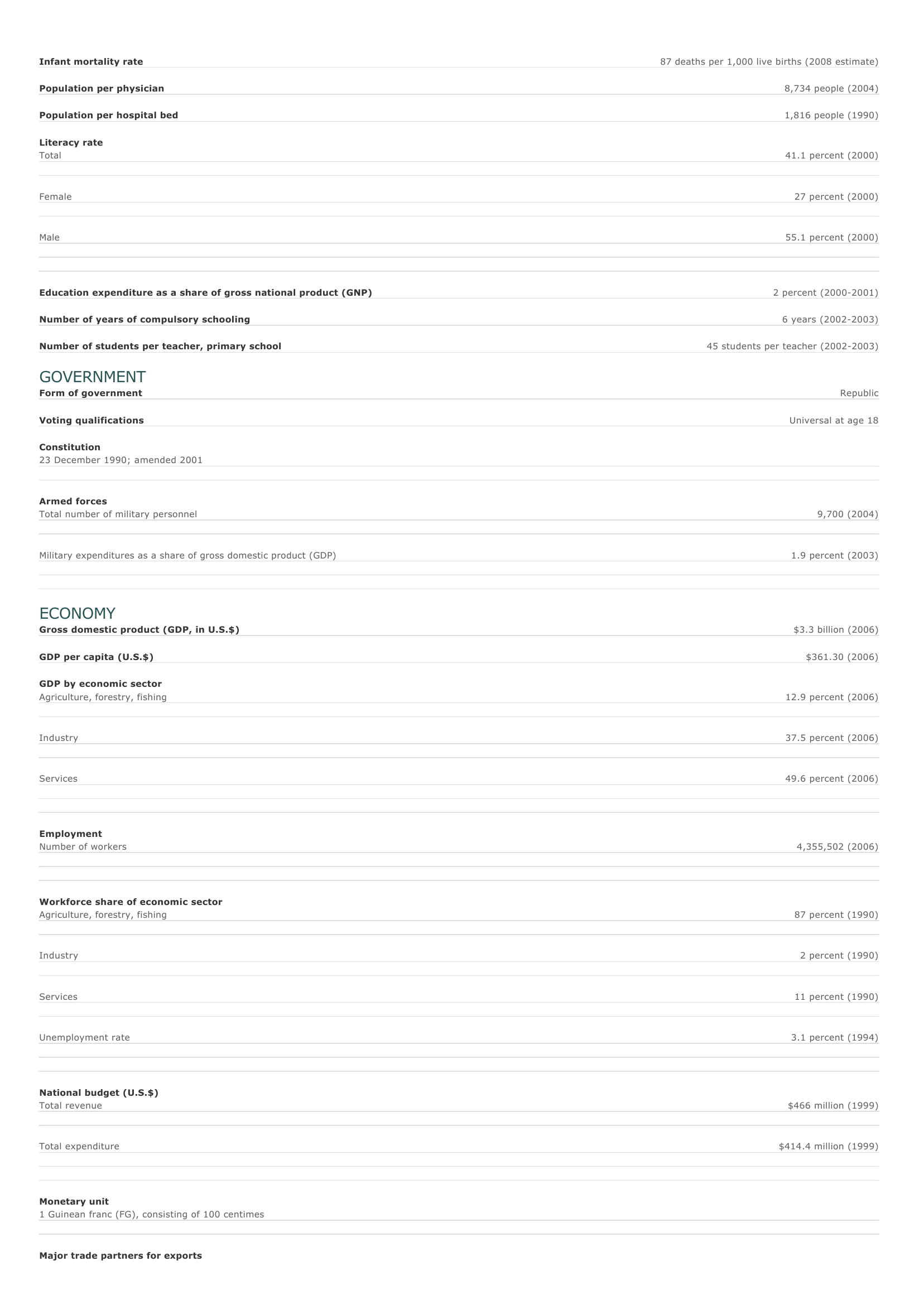Guinea Facts and Figures. BASIC FACTS Official name Capital Area Republic of Guinea Conakry 245,857 sq km 94,926 sq mi PEOPLE Population 10,211,437 (2008 estimate) Population growth Population growth rate 2.61 percent (2008 estimate) Projected population in 2025 15,806,084 (2025 estimate) Projected population in 2050 28,713,509 (2050 estimate) Population density 42 persons per sq km (2008 estimate) 107 persons per sq mi (2008 estimate) Urban/rural distribution Share urban 36 percent (2005 estimate) Share rural 64 percent (2005 estimate) Largest cities, with population Conakry 1,366,000 (2003 estimate) Ethnic groups Fulani 35 percent Mandinka 30 percent S usu 20 percent Other indigenous groups 15 percent Languages French (official); each ethnic group has its own language Religious affiliations Muslim 67 percent Indigenous beliefs 28 percent Christian 4 percent O ther 1 percent HEALTH AND EDUCATION Life expectancy Total Female Male 49.8 years (2008 estimate) 51 years (2008 estimate) 48.7 years (2008 estimate) Infant mortality rate 87 deaths per 1,000 live births (2008 estimate) Population per physician 8,734 people (2004) Population per hospital bed 1,816 people (1990) Literacy rate Total Female Male Education expenditure as a share of gross national product (GNP) Number of years of compulsory schooling Number of students per teacher, primary school 41.1 percent (2000) 27 percent (2000) 55.1 percent (2000) 2 percent (2000-2001) 6 years (2002-2003) 45 students per teacher (2002-2003) GOVERNMENT Form of government Republic Voting qualifications Universal at age 18 Constitution 23 December 1990; amended 2001 Armed forces Total number of military personnel Military expenditures as a share of gross domestic product (GDP) 9,700 (2004) 1.9 percent (2003) ECONOMY Gross domestic product (GDP, in U.S.$) GDP per capita (U.S.$) $3.3 billion (2006) $361.30 (2006) GDP by economic sector Agriculture, forestry, fishing 12.9 percent (2006) I ndustry 37.5 percent (2006) Services 49.6 percent (2006) Employment Number of workers 4,355,502 (2006) Workforce share of economic sector Agriculture, forestry, fishing 87 percent (1990) I ndustry 2 percent (1990) Services 11 percent (1990) Unemployment rate National budget (U.S.$) Total revenue Total expenditure Monetary unit 1 Guinean franc (FG), consisting of 100 centimes Major trade partners for exports 3.1 percent (1994) $466 million (1999) $414.4 million (1999) France, United States, Cameroon, Ireland, and Spain Major trade partners for imports France, Côte d'Ivoire, Belgium, United States, and China ENERGY, COMMUNICATIONS, AND TRANSPORTATION Electricity production Electricity from thermal sources 43.87 percent (2003 estimate) Electricity from hydroelectric sources 56.13 percent (2003 estimate) Electricity from nuclear sources 0 percent (2003 estimate) Electricity from geothermal, solar, and wind sources 0 percent (2003 estimate) Number of radios per 1,000 people 51 (2000 estimate) Number of telephones per 1,000 people 3 (2004) Number of televisions per 1,000 people 46 (2000 estimate) Number of Internet hosts per 10,000 people Daily newspaper circulation per 1,000 people Number of motor vehicles per 1,000 people Paved road as a share of total roads 0.48 (2003) Not available 5.2 (1997) 10 percent (2003) SOURCES Basic Facts and People sections Area data are from the statistical bureaus of individual countries. Population, population growth rate, and population projections are from the United States Census Bureau, International Programs Center, International Data Base (IDB) (www.census.gov). Urban and rural population data are from the Food and Agriculture Organization (FAO) of the United Nations (UN), FAOSTAT database (www.fao.org). Largest cities population data and political divisions data are from the statistical bureaus of individual countries. Ethnic divisions and religion data are largely from the latest Central Intelligence Agency (CIA) World Factbook and from various country censuses and reports. Language data are largely from the Ethnologue, Languages of the World, Summer Institute of Linguistics International (www.sil.org). Health and Education section Life expectancy and infant mortality data are from the United States Census Bureau, International Programs Center, International database (IDB) (www.census.gov). Population per physician and population per hospital bed data are from the World Health Organization (WHO) (www.who.int). Education data are from the United Nations Educational, Scientific and Cultural Organization (UNESCO) database (www.unesco.org). Government section Government, independence, legislature, constitution, highest court, and voting qualifications data are largely from various government Web sites, the latest Europa World Yearbook, and the latest Central Intelligence Agency (CIA) World Factbook. The armed forces data is from Military Balance. Economy section Gross domestic product (GDP), GDP per capita, GDP by economic sectors, employment, and national budget data are from the World Bank database (www.worldbank.org). Monetary unit, agriculture, mining, manufacturing, exports, imports, and major trade partner information is from the statistical bureaus of individual countries, latest Europa World Yearbook, and various United Nations and International Monetary Fund (IMF) publications. Energy, Communication, and Transportation section Electricity information is from the Energy Information Administration (EIA) database (www.eia.doe.gov). Radio, telephone, television, and newspaper information is from the United Nations Educational, Scientific and Cultural Organization (UNESCO) database (www.unesco.org). Internet hosts, motor vehicles, and road data are from the World Bank database (www.worldbank.org). Note Figures may not total 100 percent due to rounding. Microsoft ® Encarta ® 2009. © 1993-2008 Microsoft Corporation. All rights reserved.



